- Top Page
- Recent achievements of our research_4

Recent achievements of our research
Ceramic Matrix Composites Center (CMC Center)
Director Yutaka KAGAWA (Ceramic Matrix Composites Center)
Since its establishment in April 2017, CMC Center, part of TUT’s KARL, has been promoting research aimed at the practical application of CMC to a variety of critical industrial components, such as aircraft engines. Some of its research is conducted under the auspices of METI, MEXT, and the Cabinet Office. Some other collaboration is with Japanese corporations.
1. Sustainable Society Enabled by CMC
The aircraft engine featuring a CMC contributes to the realization of a sustainable society by reducing energy as well as CO2.
Why CMC now?
CMC is a unique material that capitalizes on ceramic’s strengths such as robustness, light weight, and high-temperature stability, while making up for its shortcomings such as brittleness. It is a fabric woven with strong fibers made of a ceramic material whose tiny voids between fibers are filled with another ceramic material. This innovative structure confines ceramic’s destruction into tiny localities while maintaining the strength of the ceramic fabric, in other words, it prevents abrupt large-scale destruction from occurring by keeping miniscule destruction low and isolated.
2. Creating CMC
You can create a CMC object by first forming a 2- or 3- dimensional shape by weaving SiC fabric into the material and then filling tiny gaps inside the fabric with the same ceramic material as the fabric.
SiC Fiber: Fiber that makes up high-temperature resistant CMC
The strength of CMC comes from the special feature of the SiC fiber that makes it up. SiC fiber was invented by the late Professor Seiji Yajima at Tohoku University in the mid-1970s. To date, only Japanese manufacturers have succeeded in mass-producing it on a commercial basis. It epitomizes the commercialization of basic research in materials science at a university.
3. Using CMC
To ensure a safe use of a CMC product, one needs to test its operation under the conditions as close as actual use. While such a test usually calls for an extensive length of time, we employ AI to test its mechanical and high-temperature performance in order to shorten the development time.
Evaluation of CMC’s stability under mechanical load at high temperatures
In many applications, CMC is exposed to high temperatures around 1,400 ℃ (2,552 ℉) for an extended length of time. To ensure safe operation of an aircraft engine, it is essential to test it for robustness over a long time under mechanical load. This is called a high-temperature dynamic test. TUT is equipped with a number of devices and facilities that can be used to conduct such tests under real life use environments and makes them available for public use. At TUT, we are also developing various test methods for quality assurance and maintenance. In addition, to help reduce materials development time, we are busy establishing accelerated test methods for quickly identifying changes that occur over a long time.
4. Examples of research on the application of CMC to practical use
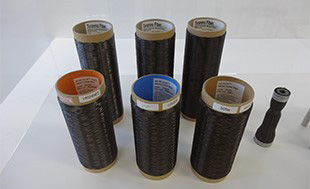
Exhibit 1
【Back row】: Tyranno-fiber SA, Tyranno-fiber ZMI, and Tyranno-fiber ZE from Ube Industries, Ltd.
【Front row】: Hi-Nicalon® Type S, Hi-Nikalon®, and Nicalon® from HGS Advanced Fibers Co., Ltd.
Bottom) Three-Dimensional Fabric (3D Fabric) (triaxial braiding) from Shikibo, Ltd.
Example of application in preforming SiC/SiC composite materials
One of the ways to fabricate a component based on SiC/SiC composite materials is to weave (preform) SiC fiber into a shape of the target it beforehand, applying complex weaving techniques such as three-dimensional weaving and braid weaving.
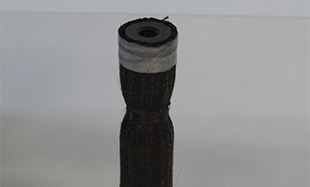
Exhibit 2
Silicon carbide fiber (SiC fiber)
This high-strength, high heat-resistance silicon carbide fiber is a prime example of CMC’s application based on SiC/SiC composite materials
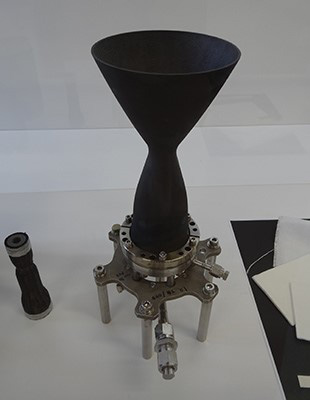
Exhibit 3
C/SiC Combustion Chamber and Nozzle (after combustion test at 1,650 ℃ (3,002 ℉))
【exhibited by JAXA】
Example of application of SiC/SiC composite materials
SiC/SiC combustion chamber and the nozzle for a rocket engine powered by the combustion of N2O/ethanol
Using the SiC fabric woven (preformed) into the shape of a nozzle by triaxial braiding, the SiC matrix has been made into a composite compound by CVI.
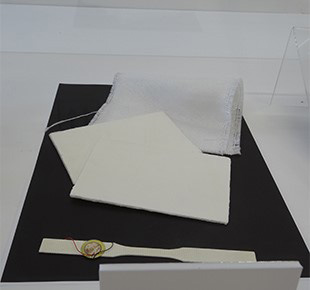
Exhibit 4
Al2O3/Al2O3 Composite Material
Example of application of Ox/Ox composite materials
This material withstands temperatures as high as about 1,000 ℃ (1,832 ℉) and is used in aircraft engines etc.
This product has been fabricated by infiltrating powder of Ox ceramics into fabric based on alumina (Al2O3) or mullite (3Al2O3・2SiO2) and then sintering it. A NEDO project established the fabrication technology and carried out performance evaluation.
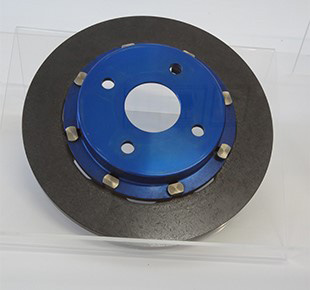
Exhibit 5
Automobile brake rotor based on C/SiC composite material (after a test run)
Example of application of C/SiC composite materials
The safety of this brake rotor for automobiles has been certified in an actual test run.
The SiC matrix has been impregnated with carbon fiber (precut into tiny pieces) and made into a composite compound by RMI. A NEDO project established the fabrication technology, which is now applied to commercial products.
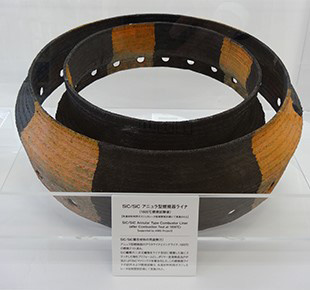
Exhibit 6
SiC/SiC Annular Type Combustor Liner
(after combustion test at 1,600 ℃ (2,912 ℉))
【supported by AMG Project】
Example of application of SiC/SiC composite materials
An annular type combustor liner consisting of an outer liner and an inner liner,after being tested at 1,600 ℃ (2,912 ℉)
First, a 2-dimensional woven fabric was laminated in the shape of a liner and made into a preform through stitching. Then the SiC matrix has been made into a composite compound by PIP method. A prototype of this burner was created and combustion-tested as part of AMG project.
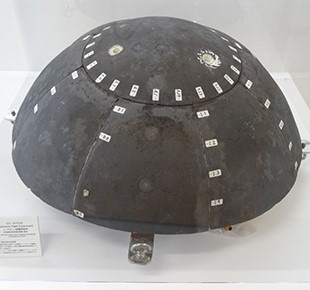
Exhibit 1
Experimental Model of C/C HYFLEX Nose corn
【exhibited by JAXA】
Example of application of C/C composite materials
This is a prototype for evaluation of a nose corn for a hypersonic flight experiment. It has undergone a heat test (evaluation of durability against extremely high temperatures generated by aerodynamic heating) on the ground.
The C matrix has been made into a composite compound by PIP method, by which a laminated preform made of C fiber and shaped like a nose corn is impregnated with a polymer.
Feel free to contact us if you have any questions.![]()